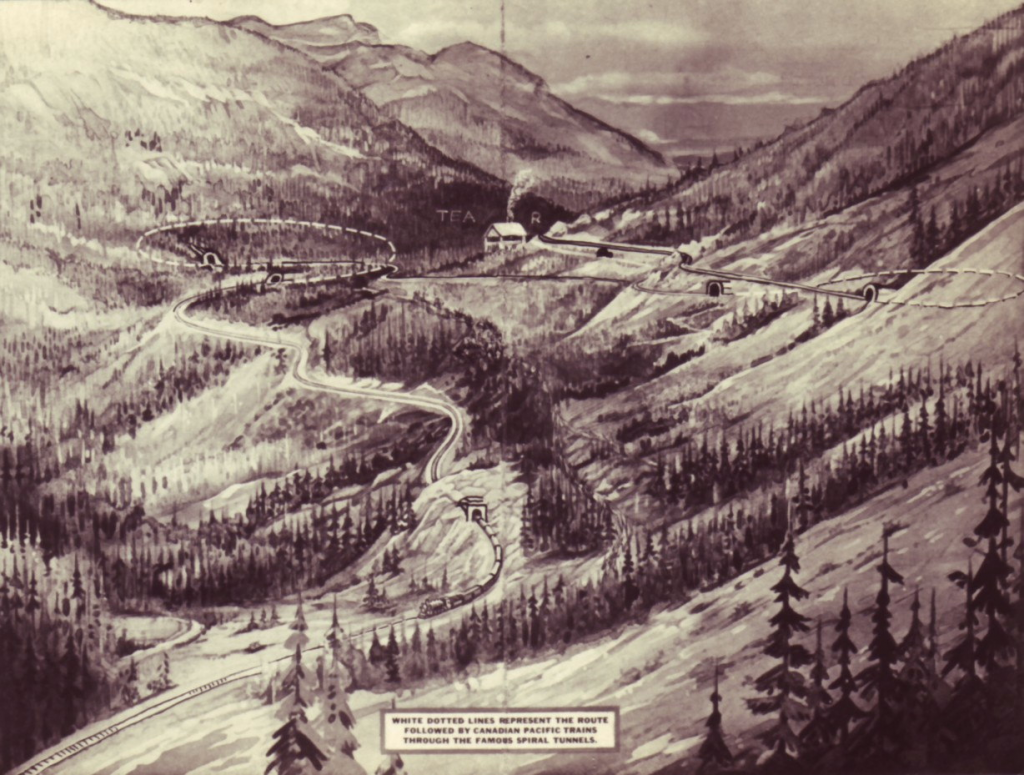

Site Location: Lat.: 50° – 58’ – 30” N.; Long. 118° – 43’ – 26” W. (GPS: 50.9750753, -118.7239493). The plaque is located at the Canadian Pacific Railway Historical Site at Cregellachie, BC. From the west, take Trans-Canada Highway 1 25.3 km past Sicamous. From the east, take Trans-Canada Highway 1 45.3 km past Revelstoke. The site is on the south side of Highway 1. There is ample parking available onsite.
Plaque Location: The plaque is mounted on a stone cairn, at the end of a short footbridge near the larger Last Spike Monument.

Description:The first passenger train on the Canadian Pacific Railway from Montreal, QC, arrived at Port Moody, BC at noon on July 4, 1886. Construction began in 1871, but bribes paid to Sir John A. MacDonald and 150 other Conservative politicians by Hugh Allen’s Canada Pacific Railway created the “Pacific Scandal”, halting progress and causing the election of Alexander Mackenzie’s Liberals in 1873. The Department of Public Works, led by Sandford Fleming, conducted surveys and carried out construction through the very challenging terrain of the Canadian Shield in northern Ontario, but progress was slow until Macdonald’s Conservatives were returned to power in 1878.
In 1880, the Canadian Pacific Railway Company, a syndicate of Montreal-based businessmen led by George Stephen, contracted with the Macdonald government to complete the railway in exchange for the sections already completed, $25 M in credit and 25 million acres (100,000 km2) of land. A southern route across the prairies was chosen that continued through the Rocky Mountains via the Kicking Horse Pass, Rogers Pass, and the Fraser Canyon. American William Cornelius Van Horne was hired in 1882 as General Manager to oversee construction across the prairies and through the Rocky Mountains. American contractor Andrew Onderdonk built much of the BC portions using 17000 workers from China. The government passed the Railway Relief Bill in 1884 providing an additional $22.5 M in loans to the CPR.
The CPR completed the International Railway of Maine in 1889 and purchased the New Brunswick Railway to create a link between Montreal and Saint John, NB, and so then became a transcontinental railway.

Historical Significance:The Canadian Pacific Railway was Sir John A. Macdonald’s National Dream, a promise that induced British Columbia to join Confederation in 1871. When completed, it was by far the longest railway ever constructed. Although troubled by delays and scandal, it was a remarkable example of engineering achievement and political will for a sparsely populated country with difficult terrain.
The southern route through Kicking Horse Pass was selected instead of Sandford Fleming’s proposed northern route through more arable lands in northern Alberta and the Yellowhead Pass, because it was more direct and made it more difficult for other railways to encroach on Canadian territory.
The CPR played a major role in the settlement and economic development in Western Canada.
The engineering and construction challenges, particularly through Northern Ontario and British Columbia, were formidable. The grades through Kicking Horse Pass, at the Continental Divide, were as large as 4.5% until that section was replaced with unique system of spiral tunnels in 1909. The Connaught Tunnel, an 8 km (5 mi.) tunnel under Mount Macdonald, was the longest railway tunnel in the Western Hemisphere when it opened in 1916.


Plaque Wording: CSCE. National Civil Engineering Historical Site. CANADIAN PACIFIC RAILWAY. A tribute to the Engineers who surveyed and supervised the construction of the railway. 1876 – 1885. Canadian Society for Civil Engineering Centennial, 1887 – 1987.
SCGC. Site Historique National de Génie Civil. CHEMIN DE FER CANADIEN PACIFIQUE. Un hommage aux ingénieurs qui ont arpenté et dirigé la construction du chemin de fer. 1876 – 1885. Société canadienne de génie civil centenaire, 1887 – 1987.
Links to Online Documentation:
Vancouver Public Library Canadian Pacific Railway Collection